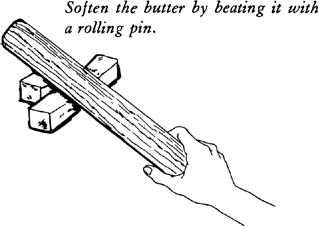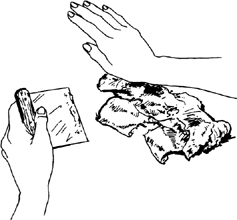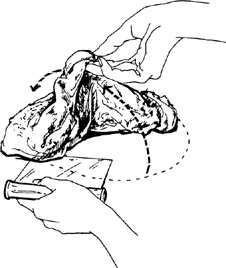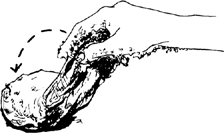Mastering the Art of French Cooking, Volume 2 (39 page)
Read Mastering the Art of French Cooking, Volume 2 Online
Authors: Julia Child

For about ½ pound of flour, making 2⅔ cups of unrisen dough, enough to fill one 6-cup mold or nine to ten ½-cup molds
1)
The preliminary dough mixture—le fraisage
3 eggs (U.S. graded “large”; if chilled, place in warm water for 5 minutes)
A 2-cup measure
A fork
Warm the eggs if chilled. Break them into the measure and blend with a fork. You should have ⅔ cup.
1 cake fresh yeast (0.6 ounce) or 1 package dry-active yeast
3 Tb warm water (not over 100 degrees) in a measure
1 tsp sugar
Mix the yeast in the warm water, add the sugar, and let yeast liquefy completely.
1¾ cups (about 8 ounces) all-purpose flour (measure by scooping dry-measure cups into flour and sweeping off excess)
A 3- to 4-quart mixing bowl
A rubber spatula
2 tsp sugar
1¼ tsp salt
A pastry scraper or stiff spatula
Measure the flour into the mixing bowl. Make a well in the center with the rubber spatula and pour in the eggs. Sprinkle on the additional sugar and the salt; scrape in the liquefied yeast mixture. Cut and stir liquids and flour together with a rubber spatula, then turn out onto kneading surface, scraping bowl clean. Dough will be very soft and sticky. Work it with scraper or stiff spatula for a moment to blend ingredients completely, then scrape to side of kneading surface and let dough rest while you prepare the butter, next step.
2) 6 ounces (1½ sticks) chilled unsalted butter A rolling pin |
|
| Smear it out with a scraper, spatula, or the heel of your hand until it is soft and malleable but still cold |
3)
Kneading—pétrissage
This will be a very soft and sticky dough that now contains the minimum amount of flour; you will probably knead in more if dough remains too soft. Knead with one hand, keeping the other clean for emergencies.
Using scraper or spatula, start flipping the near side of the dough over onto the far side |
|
| When dough has enough body, |






